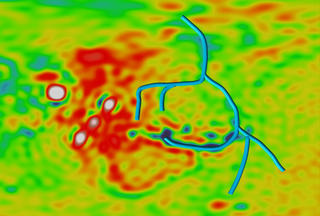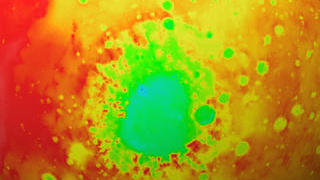Mars Standard-Definition Materials
Overview
Mars has long been a focus of NASA missions and research. This gallery contains standard-definition visualizations of NASA's Mars data, missions, and science.
Mars Science
Computer Simulations of the Martian Atmosphere Interacting with the Solar Wind
Go to this pageMars possesses no significant intrinsic magnetic field. The absence of magnetic protection allows the supersonic solar wind flow to directly interact with the Martian ionosphere (an almost fully ionized region of the Mars upper atmosphere). When the velocity of the solar wind increases, the Martian ionosphere is compressed and the ionopause (a boundary layer between the ionosphere and the solar wind) is displaced to lower altitudes. The ions of planetary origin such as O+ and O2+ escape from the upper atmosphere of Mars due to solar wind induced scavenging processes. Many more planetary ions are scavenged when the solar wind velocity increases because a much larger part of the planetary atmosphere is exposed to the solar wind as the ionopause is pushed inwards towards the planetary surface. There are some indications that the solar wind flow, as well as the Sun's x-ray and extreme ultraviolet radiation, were much more intense early in solar system history. It is thought that some 3.5 billion years ago, these extreme interplanetary conditions may have caused a much larger rate of water loss from the Martian atmosphere. We estimate that the solar wind scavenging pictured here under the extreme conditions in the early solar system would have caused the loss of a 10 meter global equivalent ocean layer from Mars over the last 3.5 billion years. This loss is less than one tenth of the 156 m global equivalent ocean layer estimated to have existed on early Mars using the Mars Global Surveyor observations. Arrows represent the flow of the ions of planetary origin. The colors represent the density of the Martian ionosphere, with red as high and blue as low. ||
Mars Instruments
- Link
Sample Analysis at Mars (SAM)
Go to this pageSample Analysis at Mars (SAM) is a suite of instruments developed for use on the Mars Science Laboratory. By looking for evidence of water, carbon, and other important building blocks of life in the Mars soil and atmosphere, this suite will help answer one of humankind's biggest questions about the planet: did it ever support life? SAM was designed and built in an international collaboration between Goddard Space Flight Center, the Jet Propulsion Laboratory, the University of Paris, and Honeybee Robotics. This video series highlights the mission, its objectives, and some of Goddard's contributors to the project. ||
- Link









